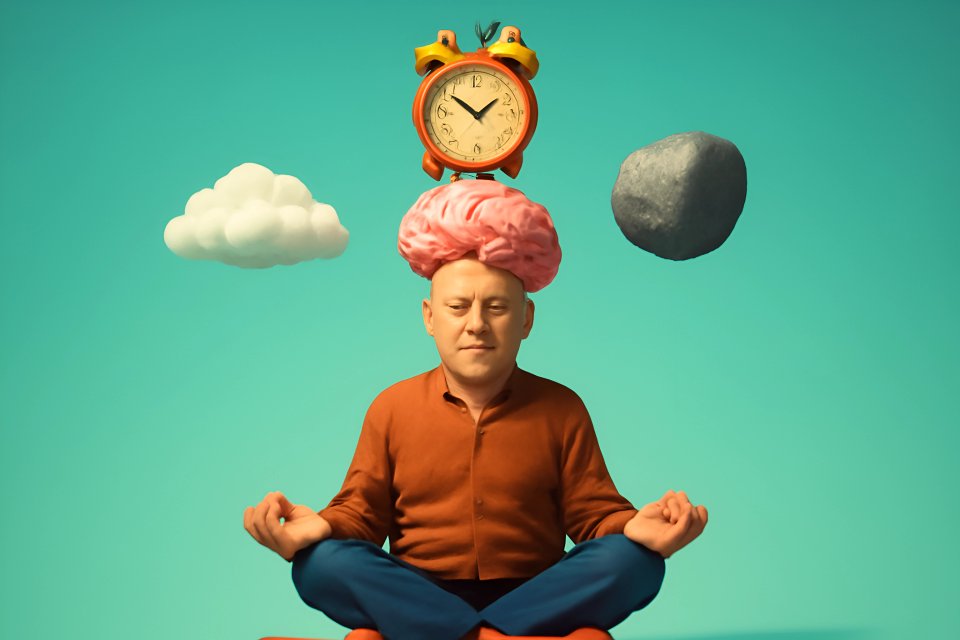
By The FitOverFifty Team
Categories: Wellness Habits, Mindful Aging
Your Blueprint for a Calmer, Healthier You
Is the "golden years" promise feeling more like a high-pressure balancing act? You’re not alone. Between career shifts, the needs of your growing family, and the quiet whispers of your own changing health, stress can feel like an unwelcome companion after 50, clinging to your days and stealing your peace.
This isn't just in your head. The reality is that this life stage brings a unique set of pressures—hormonal shifts that change your body's internal landscape, the responsibility of caring for aging parents, the looming questions of retirement, and the new aches and pains that remind you that you're not 25 anymore. It’s a perfect storm that can leave you feeling overwhelmed and depleted, robbing you of the vitality you deserve.
But what if you could build a fortress of resilience against it all? This post isn't about chasing the impossible dream of eliminating stress—it's about mastering it. We'll explore a powerful, integrative approach for stress-free living over 50, combining simple, science-backed strategies in diet, exercise, and mindfulness to forge a life filled with more calm, energy, and profound well-being.
Why Stress Feels Different After 50: The Mind-Body Connection
If you feel like stress hits harder than it used to, there’s a biological reason for it. Your body's stress-response system undergoes significant changes in midlife, altering how you process pressure. A key player is cortisol, the primary stress hormone, which can become dysregulated in older adults, leading to elevated baseline levels and a slower recovery after stressful events. For women, the menopausal transition adds another layer, as declining estrogen removes a natural buffer against cortisol, creating a cycle where hormonal shifts can heighten stress sensitivity.
This isn't just a fleeting feeling; it's the result of decades of accumulated wear and tear. Think of it as an "allostatic load," where years of minor and major stressors compound, leading to chronic inflammation, fatigue, and a weakened defense system. Research from the National Council on Aging highlights that chronic stress in older adults can lead to a 3.2 times higher risk for developing hypertension, a stark reminder of the physical toll it takes.
But here is the secret weapon you now possess: awareness. Understanding these physiological shifts isn't a cause for despair; it's your opportunity to take targeted, intelligent action. Your body and mind retain an incredible capacity for change, and by knowing exactly where the vulnerabilities lie, you can build a strategic defense that works with your biology, not against it.
Pillar 1: Fueling Calmness — Your Anti-Stress Diet
Eat to Beat Cortisol
You can quite literally eat your way to a calmer state of mind. Certain foods are packed with nutrients that directly combat the biochemical cascade of stress. Foods rich in magnesium, like leafy greens, almonds, and seeds, act as a natural brake on your nervous system, while Vitamin C-rich foods like oranges and bell peppers have been shown to curb cortisol production by 30% during acute stress.
Don't forget the power of healthy fats. Omega-3 fatty acids, found in fatty fish like salmon and in walnuts, are critical for brain health and have a profound anti-inflammatory effect. They help fortify the prefrontal cortex, the part of your brain responsible for emotional regulation, giving you more control when life throws you a curveball.
Nourish Your Gut-Brain Axis
Have you ever had a "gut feeling"? That's your gut-brain axis at work, a complex communication network linking your digestive system to your emotional centers. A healthy gut microbiome is essential for a calm mind, as beneficial bacteria produce calming neurotransmitters like GABA. You can support this vital connection by incorporating probiotic-rich foods like yogurt and kefir, and fiber-rich foods like oats and beans, into your diet.
In fact, the link is so strong that studies show a direct impact on stress hormones. One study found that older adults who consumed fermented foods daily exhibited 25% lower cortisol awakening responses, demonstrating a measurable improvement in their resilience to daily stressors. This is your internal defense system, and you can strengthen it with every meal.
Hydration for Headspace
One of the simplest yet most overlooked tools for stress management is your water bottle. Even mild dehydration can cause your body to produce more cortisol, leaving you feeling fatigued, irritable, and mentally foggy. Research confirms that being just slightly dehydrated can elevate cortisol levels by 15%, making it harder to cope with daily challenges.
Make hydration a non-negotiable part of your day. Start your morning with a large glass of water, keep a bottle on your desk or in your car, and sip consistently. Think of it as providing the essential fluid your brain needs to stay cool, clear, and collected under pressure.
Mindful Moderation
Just as some foods calm the system, others can act as accelerants for stress and anxiety. Excess caffeine, refined sugar, and alcohol can disrupt sleep, trigger blood sugar crashes that mimic anxiety symptoms, and deplete the very nutrients your body needs to manage stress effectively. For instance, caffeine can prolong cortisol's presence in your system for over six hours, keeping you in a state of high alert long after your coffee is finished.
This isn't about total deprivation, but strategic substitution. Swap that second cup of coffee for a green tea, which contains L-theanine for focused calm. Instead of a sugary snack, reach for a handful of almonds or a piece of dark chocolate, both of which provide magnesium and other stress-busting compounds. These small shifts can make a world of difference in your daily emotional landscape.
Pillar 2: Moving to Soothe — Exercise for Mental Resilience
Rhythmic, Low-Impact Movement
The right kind of movement is like a reset button for a stressed-out nervous system. Rhythmic, low-impact activities like brisk walking, swimming, or cycling are particularly powerful because they boost mood-lifting endorphins without jarring your joints. A daily 30-minute walk does more than just burn calories; it has been shown to lower cortisol levels by an impressive 22% and even helps combat stress-related brain atrophy.
The key is finding a rhythm that feels good for your body and mind. The steady pace of your feet on the pavement or the smooth glide of your arms through water creates a meditative effect, clearing your head and dissolving tension. For a deeper dive into finding the right activity for you, explore these low-impact cardio ideas for heart health.
Strength Training for a Stronger Mind
Building physical strength has a profound and direct impact on your mental and emotional resilience. When you lift weights or use resistance bands, you're not just building muscle; you're building a sense of capability and control over your body. This feeling of empowerment translates directly into how you handle life's stressors.
Furthermore, strength training provides incredible biochemical benefits. Just two sessions a week can improve your body's stress adaptation by boosting a critical protein called BDNF (brain-derived neurotrophic factor). If you have concerns about joint pain, you don't have to miss out; there are many safe and effective ways to build strength, and these practical strength training modifications for seniors with joint pain can show you how.
Flexibility and Tension Release
Where does stress live in your body? For many of us, it settles in the neck, shoulders, and back, creating a constant state of physical tension. Practices like gentle yoga, Tai Chi, or a dedicated stretching routine are powerful tools for releasing this stored tension and calming the nervous system.
Mind-body disciplines like Tai Chi have been found to reduce perceived stress scores by 35% in seniors by improving the balance of your autonomic nervous system. Even a few minutes of gentle stretching before bed can signal to your body that it's time to let go of the day's worries, paving the way for more restorative sleep.
Pillar 3: Cultivating Peace — Simple Mindfulness for a Busy Life
The 5-Minute "Breathe and Be"
Mindfulness doesn't have to mean sitting in silent meditation for an hour. You can rewire your brain's response to stress in just five minutes a day with a simple, powerful breathing technique. It's about noticing, not clearing your mind.
Try this right now. Sit comfortably and gently close your eyes.
Inhale slowly through your nose for 4 seconds.
Hold the breath gently for 2 seconds.
Exhale slowly through your mouth for 6 seconds.
Repeat for 5 minutes.This simple practice of extending your exhale stimulates your vagus nerve, activating your body's relaxation response. It's so effective that it can immediately lower systolic blood pressure by 10-15 mmHg, giving you an instant tool to find calm in any situation.
Mindful Moments in Your Day
The true power of mindfulness comes from weaving it into the fabric of your existing life. You don't need to add more to your to-do list; you just need to bring more awareness to what you're already doing. Turn your morning coffee into a sensory meditation by noticing the aroma, the warmth of the mug, and the taste of each sip.
When you walk to the mailbox, feel your feet connecting with the ground. This practice of "mindful walking" has been shown to reduce anxious, ruminating thoughts by 28%. By anchoring your attention in the present moment, you rob stress of its power, which thrives on worries about the past and future.
The Power of a Gratitude Pause
Stress narrows our focus, causing us to see only what's wrong. A gratitude practice intentionally widens that lens, rewiring your brain to notice the good that is always present. It's a simple but profound shift in perspective.
Before you go to sleep tonight, take just one minute to mentally note three specific things you were grateful for today. It could be the taste of your lunch, a kind word from a friend, or the comfort of your bed. This simple habit shifts your brain from a state of threat detection to one of safety and contentment, and research shows it can improve sleep onset latency by an average of 15 minutes.
The Integrative Blueprint: Weaving It All Together for Lasting Results
How Synergy Works
This is where the magic happens. These pillars don't just work in isolation; they amplify one another in a powerful, upward spiral of well-being. A nutrient-dense breakfast gives you the stable energy for a stress-busting walk. That walk clears your mind and helps you sleep more deeply, which in turn lowers your baseline cortisol and makes it easier to practice mindfulness with a clear head the next day.
Each positive action creates the foundation for the next, building momentum that makes healthy choices feel easier and more natural over time. This is the essence of an integrative approach—creating a resilient system where every part supports the whole. You're not just fighting stress; you're building a life that is fundamentally more stress-proof.
Your "Stress-Resilience" Starter Plan (A Sample Day)
Seeing how it all fits together can make it feel more achievable. Here is a simple blueprint for what an integrated, stress-resilient day could look like.
| Time of Day | Action | Benefit |
|---|---|---|
| Morning | Start with a glass of water & 5 minutes of stretching. Enjoy a protein-and-fiber-rich breakfast (e.g., Greek yogurt with berries and nuts). | Hydrates the brain, releases overnight tension, and stabilizes blood sugar for steady energy and mood. |
| Afternoon | Take a 15-minute mindful walk after lunch, focusing on your breath and the sensation of your feet on the ground. | Aids digestion, prevents a post-meal slump, and provides a mental reset to tackle the rest of your day with clarity. |
| Evening | Enjoy a balanced dinner. Before winding down, practice a 5-minute gratitude pause, noting three good things from your day. | Nourishes your body for overnight repair and shifts your mindset from stress to contentment for better sleep. |
The "One Thing" Rule
Feeling overwhelmed by this list? That's perfectly normal. The secret to lasting change is to reject the "all or nothing" mindset. Instead, embrace the "One Thing" Rule.
Look back over the pillars of diet, exercise, and mindfulness. What is one small habit that feels both appealing and achievable for you to implement this week? Maybe it's adding a 10-minute walk after dinner, swapping your afternoon soda for a glass of water, or trying the 5-minute breathing exercise. Start there. Master that one thing, feel the success, and then build from there.
Your Journey to a More Peaceful Chapter
Managing stress after 50 isn't about finding a magic pill. It's about understanding that you have the power to create profound calm and vitality by holistically supporting your body and mind through the integrated pillars of diet, movement, and mindfulness. Each pillar reinforces the others, creating a powerful synergy that builds unshakable resilience from the inside out.
It is never too late to reclaim your calm. By taking these small, integrated steps, you are not just coping with stress—you are actively investing in a future filled with more energy, joy, and peace. You have the wisdom, the experience, and now the blueprint to make your next chapter your most vibrant and peaceful one yet.
What is one small step you will take this week for a more stress-free life? Share your commitment in the comments below—we’d love to cheer you on!
Ready to put mindful movement into action? Our guide on How to Build a Low-Impact Exercise Routine Over 50 is the perfect next step to create a safe and sustainable practice.
















